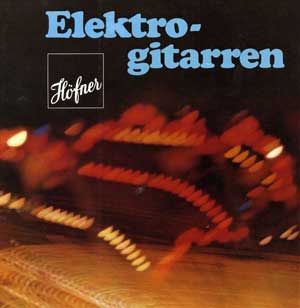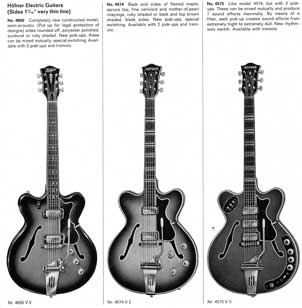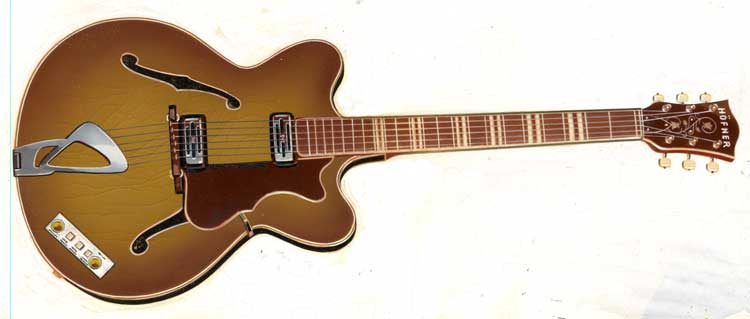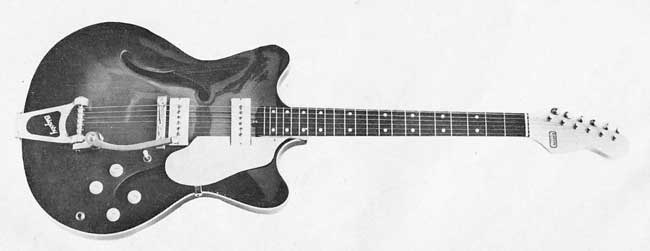



1968 Hӧfner Catalogue showing their 4600, 4574, and 4575 very thin bodied models in that year.
We have discussed earlier how and maybe why the Hӧfner Verithin model appeared in the Selmer London catalogue of 1960. Hӧfner realised straight away that they had a winner on their hands so they also made the same guitar available for the rest of the world under the 4574 model designation. However, this guitar was strictly speaking a very thin, thinline archtop and not a true semi. This is because of its fully hollow body construction. As explained in Chapter 5, the “semi-acoustic” title is generally the name given to a guitar with part of its body being of solid construction and part hollow, usually constructed with a timber block running up the center of the body in contact with both the body top and back, but having acoustic “wings” on each side. The “semi-acoustic” form of construction was pioneered by Gibson with their highly successful 335/345/355 range of guitars. As well as acting as a “tone block”, the center solid area also provides the guitar maker with a solid foundation for the bridge, a “stop” tailpiece if required, and for mounting the pickups. From the gigging guitarist’s point of view, feedback through amplification, which has always been a problem at high volume levels with fully-acoustic bodies, is virtually eliminated.

The 4574 model was basically the
same as the Verithin, but with more options. Firstly, it was offered with a
choice of either one or two pickups from its introduction through to 1965.
However, you would be hard pressed to find a genuine single pickup 4574 these
days, and that may well be why Hӧfner bowed to the inevitable and supplied two
pickup guitars only from 1966. Secondly, it was initially issued in brown
sunburst, but although this is how the model was marketed for many years, most
4574’s do seem to have been finished in cherry red (or russet brown for early
examples.) Finally, instead of the “Lyre”-style tailpiece that was fitted to
every non-Bigsby Verithin, many of the 4574s were fitted with the beautiful ABM
“Jazz” tailpiece.
So, in fact Hӧfner maximised on the Selmer-distributed
Verithin concept by making an identical guitar available to the rest of the
World with the 4574 designation. This was introduced at the 1960 Frankfurt
Spring Trade Show but, if one digs deep enough into the Hӧfner archives, one
discovers that two other similar guitar models were also listed in the 1960 “New
Releases” catalogue.
The more familiar of these was the Hӧfner 4572, which
really was a 4574 but with a single body cutaway. This model came in just one
finish, and that was cherry red. The first examples were given twin gold stripes
running around the body sides, but these appear to have been discontinued at an
early stage in the model’s production period.
The third new model in Spring 1960 is rather a mystery.
It was designated as the Hӧfner 4564 and described as a thinline (presumably
50mm body depth) version of the 457 archtop model but with twin symmetrical body
cutaways as the 4574. A guitar that matches something like that description is
visible in a photograph of the 1960 Milan Trade Fair, but other than
that…..nothing! It never appeared in any of Hӧfner’s regular price lists, so
let’s pass over that one; it is supposed to be a section about very thin-bodied
guitars after all!
In 1964/65, a three pickup version of the 4574 appeared,
and this was given its own model designation – the 4575. This guitar continued
the popular Verithin/4574 theme but was given rather complex passive electronics
that included a small pickup selector console with three individual slide
switches. The moon-shaped main console located down on the lower bout included a
solo/rhythm selector switch plus level control, plus the usual rotary volume and
tone controls.
Hӧfner had supplied Selmer London with a twin Florentine
cutaway version of the Verithin model from 1965 onwards. Selmer wanted to call
this the Verithin “66”, but Hӧfner put Verithin Deluxe labels inside the body of
around 200 guitars until from 1966 onwards Selmer got the situation under
control from when “Verithin 66” was correctly typed on the body labels. It does
not seem to have sold particularly well in the UK, but Selmer persisted with the
model until around 1972 by which time sales had totally stalled. Only 27 “66”s
seem to have been shipped to Selmer during 1968 through to 1972. This situation
may well have prompted Hӧfner, in a converse way, to introduce an identical
guitar designated the 4576 model in 1967 for their general World market.
The method of manufacture usually adopted by Hӧfner was
to produce completed bodies and necks in batches of at least 20 and often
considerably more. These would be stockpiled in the storeroom until an order
came in, and then sufficient of the necks and bodies to complete the order would
be mated together, finishes and hardware applied, and the completed guitars
shipped out. It is surely more than coincidence that when sales of Selmer models
such as the Verithin and President Florentine guitars ran out of steam in the
UK, identical “new” guitar models appeared in Hӧfner’s general catalogue. The
theory that Hӧfner were using up stockpiled parts and probably fully completed
Verithin “66”s that had been destined for Selmer is further reinforced by the
variety of different electrical fittings to be found on examples of the 4576,
which itself was discontinued in 1970.
By 1966, Hӧfner must have fully appreciated the
popularity of the 30mm deep bodied twin-cutaway guitars, and were presumably
wondering how to capitalise further on this formula. The models produced to date
had been above-average quality, with beautifully inlaid headstocks and
fingerboards, plenty of body edge purfling, bound necks, good quality timber
veneers, etc. This had presumably all been fully to Ben Davies’ satisfaction as
he liked Selmer to sell good quality products, but perhaps a cheaper very-thin
guitar would appeal to a new market of budget-conscious customers?
Walter Hӧfner soon had designed a suitable product which
was designated the Hӧfner 4600. This guitar was given a bolt-on neck for speed
of production, no binding/purfling around the body edges (although the neck and
strangely the sound holes were bound), simple dot fretboard markers, and a
simple dagger inlay and plastic logo on the headstock. Judging by the number of
4600 examples which are still around, this guitar sold very well indeed. Perhaps
that is no wonder, as the German catalogue price in 1964 for a Hӧfner 4600/E2
was DM 390, as against DM 480 for the 4574/E2.
A
couple of years later in 1968, Hӧfner took the “budget Very Thin” principal to
another level when the 4573 model was introduced. This actually had a 40mm (2½”)
deep body, thus placing it mid-way in size between the 4574 variants (30mm) and the archtop thinlines
(50mm). Costs were again reduced however by the use of a bolt-on
neck, no binding around the edges of the body back, a simple dagger inlay in the
headstock, and simple dot fret markers. This model obviously did not prove to be
popular, as it had been dropped from the catalogue by the end of 1968.

c1981 Carvin SH225 Model with a "Verithin" style body
The profile of Hӧfner’s double Venetian cutaway as used on such guitars as the 4574/Verithin was substantially different to that used on most competitors’ guitars. It was much less pronounced than let’s say the Gibson335/45/55 models. However, it would seem that Ovation preferred a more pronounced cutaway shape and so, as can be seen from the Ovation Tornado illustrated above, the bodies provided to them by Hӧfner were of a completely different profile to anything that Hӧfner had previously produced for their own models. As well as having cutaway horns that had certain similarities to Mickey Mouse’s ears, the sound holes in the body top did not have Hӧfner’s usually stylish flow about them.
In 1968, Hӧfner progressed
to their own version of the Ovation Storm, using the same "Mickey Mouse" body
shape. This was given the
designation 4572, which was the second time this number had been used by Hӧfner,
so we shall call it the 4572(ii) model. The body was identical to that supplied
for the “Storms”, but Hӧfner used the same bound bolt-on neck that had been used
on the 4600. A variety of pickups were used on the guitar, including the Type
511(iii) Schaller-made pickups, Hi-Fi pickups, as well as the usual Type 513 “Blade” units. As
far as the catalogue was concerned, the only option was Hӧfner’s Bigsby-like
vibrato tailpiece, but some 4572(iii) examples can be found with active
circuits.
The guitar appears to have sold very well, both in
Europe and in the US where it regularly appeared in the Sorkin/Multivox
catalogues. This happy situation resulted in Hӧfner’s Micky Mouse guitar being
produced until 1988, giving a very respectable production period of 21
years!
As a post-script, it must be mentioned that Hӧfner, probably as a result of the above success story, did actually produce a “deluxe” version of the 4572(ii) between 1971 and 1982. This was called the Hӧfner 4580. The additional luxury came in the form of a larger “double-diamond” mother of pearl headstock inlay, block fret-markers, and a classy dark brown stained body top with a walnut stain on the body back. Initially Hӧfner’s Type 515 Studio pickups were fitted, but later examples had the Hӧfner 513 Blade and then the Schaller-made Type 516 twin-coil units.
c1972 Hӧfner 4580V fitted with Type 516 pickups.
In 1976, a version of the 4580 was made for the
Frankfurt Show of that year which was fitted with Type 516 pickups with coil
taps. This was designated as the 4582. It never even made it into the
catalogues.
A rather strange guitar appeared in the Selmer London
catalogue of Autumn 1966. This had the same body as the Höfner 500/1 violin bass
but with conventional 6-string guitar tuning and a 22-fret fingerboard and
headstock decorated in a similar way to the Verithin model. The neck had a
bolt-on connection to the body instead of the glued joint used on the bass
model. Two Type 511 “Staple” pickups were initially fitted, with simple single
volume and two individual tone rotary controls. A three-way selector was fitted
for controlling the pickups.
This guitar was introduced to Höfner’s general market a
few months later in 1967 under the model designation of “459”, a rather
confusing idea as this model number had previously been used for a more
conventional archtop model made between 1952 and 1960. In the Selmer catalogue
the new guitar was simply described as the “Höfner Violin Bass”. Because the
Selmer version appeared before the general market model, perhaps we can assume
that this was yet another model that had been suggested to Höfner by Selmer,
presumably in an attempt to maximise on the Beatles success and Paul McCartney’s
use of a Höfner 500/1 bass guitar.
Unfortunately for Selmer however, the little guitar
doesn’t seem to have been received very well by the British guitar-playing
community, and maybe less than a hundred were sold by Selmer before it was
dropped after a year or so. However, the 459(ii) was certainly welcomed in the
United States in particular, where they were described as “Beatle Electric
Guitars” by Sorkin, the distributor of Höfner guitars in the States at that
time. Höfner reacted by offering the option of various active circuits such as
just simply a Treble Boost (459/T), a Fuzz-Tone (459/Z), or both together which
with a Höfner vibrato tailpiece resulted in the 459/VTZ version. Most 459(ii)
guitars sold in the US do appear to have been active electrics models, and as
the new Type 513 “Blade” pickup was adopted by Höfner in early 1967, so the
majority of all versions of the 4599(ii) guitars are fitted with this unit.
Finally,
in 1968, Höfner offered, as further options, the ultimate variants – the Super
459 TZ and Super 459 VTZ. These guitars followed the same basic principles as
previously described but with the blonde finish, the additional purfling,
five-piece neck, mother of pearl double arrow-head fretmarkers, and the gold
plating used on Hӧfner’s deluxe violin bass, the 5000/1.
All 459 versions disappeared from the catalogues during
1970, presumably after the initial impact of the Beatles in the US had died
down.
1970 was in the period where Hӧfner
were suffering badly from Japanese imports – copies of the US favourites such as
the Gibson Les Paul and the Fender Strat were flooding into Hӧfner’s traditional
markets -
Europe and the US. Hӧfner had no choice but to also commence producing some
copies. However, they approached this rather unsavory situation with
considerable caution and with an obvious dislike for simply turning out
identical US-looking guitars as the Japanese were doing. So...... how to make a guitar that would appeal to Les Paul
buyers, but not lay the company open to allegations of blatant plagiarism? Well,
how about making a semi-acoustic version of the Les Paul?
The Hӧfner 4579 model was conceived in time for the
1970 catalogue. It would actually be more accurate to say that this was a
Club-style guitar in Hӧfner’s old tradition, but with a center block running up
the body in order that a stop-tailpiece could be used, a 42mm (1¾”) deep body,
and the four rotary controls/three way selector switch electrics arrangement as
used on the Les Paul. The body cutaway was Venetian, as opposed to the pointed
Florentine horn adopted on the Les Paul.
Needless
to say, Hӧfner quickly realized that such an instrument was not really what the
average Les Paul enthusiast was aspiring to, and so the hollow-bodied 4579 was very quickly
dropped and another guitar which we shall call the 4579(ii) substituted in its
place. This was of mainly solid construction, but with a pressed maple laminate
top
strutted up off the lower solid section of the body. At least now though this
solid version had a Florentine cutaway!
__________________________________________________
All Text is Copyright
© 2022 Steve Russell. All Rights Reserved